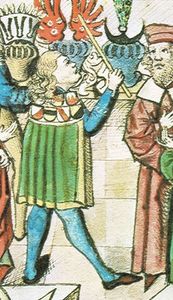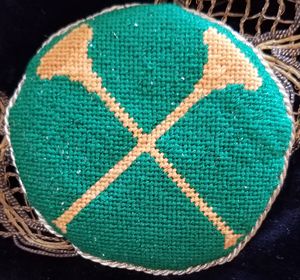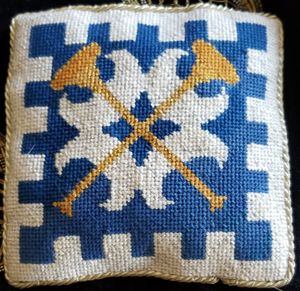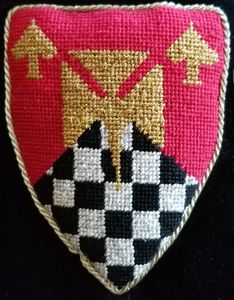Heraldic Mantle of Giles Hill: Difference between revisions
BaronGiles (talk | contribs) No edit summary |
BaronGiles (talk | contribs) No edit summary |
||
| Line 5: | Line 5: | ||
==Freelance Heralds== | ==Freelance Heralds== | ||
Medieval heralds generally worked for a single patron (which could be a monarch or other | Medieval heralds generally worked for a single patron (which could be a monarch or other noble personage, or an Order of chivalry). When speaking for the principal, the herald would wear a tabard bearing the arms of their patron, symbolizing the fact that the herald spoke not on their own behalf, but with the voice of their liege. Some heralds, however, were available to be hired to speak for anyone needing their services, and made this known by wearing mantles bearing the arms of their various employers. | ||
The Society's heralds | The Society's heralds typically wear a tabard displaying the arms of the territory they serve. Occasionally a tabard bearing personal arms will be seen; this may be in tournaments of great pageantry, like Crown Tournies or pas d'armes, or a court ceremony like a coronation or elevation to the peerage. But given the expense of creating a heraldic tabard, not only in materials, but in the artisan's labor, personal heraldic tabards (distinct from armorial surcotes or other garments which bear the arms of the wearer) are quite unusual. | ||
Dr Lynsey Darby, | Dr Lynsey Darby, a former Archivist of the College of Heralds in London, reveals that Randolf Jackson, appointed Montorgeuil poursuivant by Henry VII in early 1486, provided heraldic services for the 135 Seigneurial families of Jersey. The Governor of Jersey, Matthew Baker, presented an expense claim<ref>The claim is preserved in the National Archives at Kew, and partly re-printed in the Rolls Series No24 and also cited in ms ‘38 B.18 p. 97’ by John Anstis, Garter KoA.</ref> for a Tabard provided for Montorgeuil, "broidered with the devices of many Houses"<ref> I am indebted to Julian Wilson, on the FaceBook [https://www.facebook.com/groups/SCAHeraldryChat/10158603113464203/?comment_id=10158605330924203&reply_comment_id=10158606152054203¬if_id=1588022643216638¬if_t=group_comment&ref=notif SCA Heraldry Unofficial Chat, for this information.</ref> | ||
<gallery widths=300px heights=300px perrow=3> | <gallery widths=300px heights=300px perrow=3> | ||
| Line 18: | Line 18: | ||
==Construction of the Mantle== | ==Construction of the Mantle== | ||
The mantle is in the form of | The mantle is in the form of a three-quarter circle Elizabethan fingertip cape, circa 1580. It is made of black silk velvet, trimmed with gold bullion gimp, and ornamented with heraldic badges and the arms of the territories and peers Giles has served as herald. | ||
==Territorial Arms and Badges on the Mantle== | ==Territorial Arms and Badges on the Mantle== | ||
| Line 29: | Line 29: | ||
Image:Giles_HeraldsBadge.jpg|[[Wiki_Pagetitle|Plain text display]] <br>Vert, in saltire two trumpets Or. Additional information. | Image:Giles_HeraldsBadge.jpg|[[Wiki_Pagetitle|Plain text display]] <br>Vert, in saltire two trumpets Or. Additional information. | ||
Image:Giles_CaidanHeraldsBadge.jpg|[[Wiki_Pagetitle|Plain text display]] <br>Blazon. Additional information. | Image:Giles_CaidanHeraldsBadge.jpg|[[Wiki_Pagetitle|Plain text display]] <br>Blazon. Additional information. | ||
</gallery> | </gallery> | ||
| Line 42: | Line 35: | ||
The (approximate) finished dimensions are 4" tall, 3.5" wide. They are canvaswork (also called tentwork and needlepoint) worked on 18 - 22 count needlepoint canvas, in cotton, linen, or silk. | The (approximate) finished dimensions are 4" tall, 3.5" wide. They are canvaswork (also called tentwork and needlepoint) worked on 18 - 22 count needlepoint canvas, in cotton, linen, or silk. | ||
<gallery widths=300px heights=300px perrow=3> | <gallery widths=300px heights=300px perrow=3> | ||
Image:Giles_Augustine.jpg|[[Augustine_von_Freiburg|Augustine von Freiburg]] <br>Per chevron gules and checky sable and argent, a cross formy fitchy and in chief 2 card-piques Or. Sir Augustine was elevated to the [[Order of the Chivalry]] on October 6, 2007 by [[Drogo and Iðuna]], King and Queen of Caid. On September 5, 2010 he was elevated to the [[Order of the Pelican]] by [[Conrad and Eleanor]], King and Queen of Caid. | Image:Giles_Augustine.jpg|[[Augustine_von_Freiburg|Augustine von Freiburg]] <br>Per chevron gules and checky sable and argent, a cross formy fitchy and in chief 2 card-piques Or. Sir Augustine was elevated to the [[Order of the Chivalry]] on October 6, 2007 by [[Drogo and Iðuna]], King and Queen of Caid. On September 5, 2010 he was elevated to the [[Order of the Pelican]] by [[Conrad and Eleanor]], King and Queen of Caid. | ||
Revision as of 09:38, 28 April 2020
Freelance Heralds
Medieval heralds generally worked for a single patron (which could be a monarch or other noble personage, or an Order of chivalry). When speaking for the principal, the herald would wear a tabard bearing the arms of their patron, symbolizing the fact that the herald spoke not on their own behalf, but with the voice of their liege. Some heralds, however, were available to be hired to speak for anyone needing their services, and made this known by wearing mantles bearing the arms of their various employers.
The Society's heralds typically wear a tabard displaying the arms of the territory they serve. Occasionally a tabard bearing personal arms will be seen; this may be in tournaments of great pageantry, like Crown Tournies or pas d'armes, or a court ceremony like a coronation or elevation to the peerage. But given the expense of creating a heraldic tabard, not only in materials, but in the artisan's labor, personal heraldic tabards (distinct from armorial surcotes or other garments which bear the arms of the wearer) are quite unusual.
Dr Lynsey Darby, a former Archivist of the College of Heralds in London, reveals that Randolf Jackson, appointed Montorgeuil poursuivant by Henry VII in early 1486, provided heraldic services for the 135 Seigneurial families of Jersey. The Governor of Jersey, Matthew Baker, presented an expense claim[1] for a Tabard provided for Montorgeuil, "broidered with the devices of many Houses"[2]
Julian Wilson heralds a Pas d'Arms at the Ancient Hospital and Almshouse of St. Cross, in Drachanwald, near West Dragonshire (Southern England excepting London). The devices on the tabard are those of Seigneurial families of Jersey in the late 15th C, courtesy of the Librarian of our local historical Socièté Jersaise.
Construction of the Mantle
The mantle is in the form of a three-quarter circle Elizabethan fingertip cape, circa 1580. It is made of black silk velvet, trimmed with gold bullion gimp, and ornamented with heraldic badges and the arms of the territories and peers Giles has served as herald.
Territorial Arms and Badges on the Mantle
The Kingdom of Caid
Azure, a crown within a laurel wreath Or, between three crescents within a bordure embattled argent. The first SCA chapters in southern California were established in 1970, and became the Principality of Caid in 1974. Caid became independant of the West in 1978. Giles has served Caid as herald for courts across the Known World, in The West, An Tir, Atenveldt, Atenveldt, Ansteorra, Aethelmerc, and Glen Abhan. He has repeatedly served as Golden Rose Herald, the staff herald charged with producing royal courts in Caid, and was created Chrysostom Herald by Sven and Kolfinna.[Barony of Bonwicke]
Per pale Or and gules, a pale indented counterchanged, overall a laurel wreath vert. Bonwicke's arms were designed by Giles Hill.The Barony of Calafia
Blazon. Additional information.The Barony of Gyldenholt
Azure, three trees conjoined in fess Or, surmounted on the foliage by a laurel wreath vert, within a bordure Or. Giles served at Gold Forest during the tenure of Wulfric and Lasairfhiona, and Ursul and Collette.Plain text display
Vert, in saltire two trumpets Or. Additional information.Plain text display
Blazon. Additional information.
Personal Arms on the Mantle
The (approximate) finished dimensions are 4" tall, 3.5" wide. They are canvaswork (also called tentwork and needlepoint) worked on 18 - 22 count needlepoint canvas, in cotton, linen, or silk.
Augustine von Freiburg
Per chevron gules and checky sable and argent, a cross formy fitchy and in chief 2 card-piques Or. Sir Augustine was elevated to the Order of the Chivalry on October 6, 2007 by Drogo and Iðuna, King and Queen of Caid. On September 5, 2010 he was elevated to the Order of the Pelican by Conrad and Eleanor, King and Queen of Caid.- Giles FileName.jpg
Plain text display
Blazon. Additional information.
- ↑ The claim is preserved in the National Archives at Kew, and partly re-printed in the Rolls Series No24 and also cited in ms ‘38 B.18 p. 97’ by John Anstis, Garter KoA.
- ↑ I am indebted to Julian Wilson, on the FaceBook [https://www.facebook.com/groups/SCAHeraldryChat/10158603113464203/?comment_id=10158605330924203&reply_comment_id=10158606152054203¬if_id=1588022643216638¬if_t=group_comment&ref=notif SCA Heraldry Unofficial Chat, for this information.

![Herald with tabard and baton Tirol, Anton: Wappenbuch - BSB Cod.icon. 310 [S.l.] Süddeutschland.](/images/thumb/Giles_GermanMantle1.JPG/177px-Giles_GermanMantle1.JPG)



![[Barony of Bonwicke] Per pale Or and gules, a pale indented counterchanged, overall a laurel wreath vert. Bonwicke's arms were designed by Giles Hill.](/images/thumb/Giles_Bonwicke.jpg/211px-Giles_Bonwicke.jpg)




